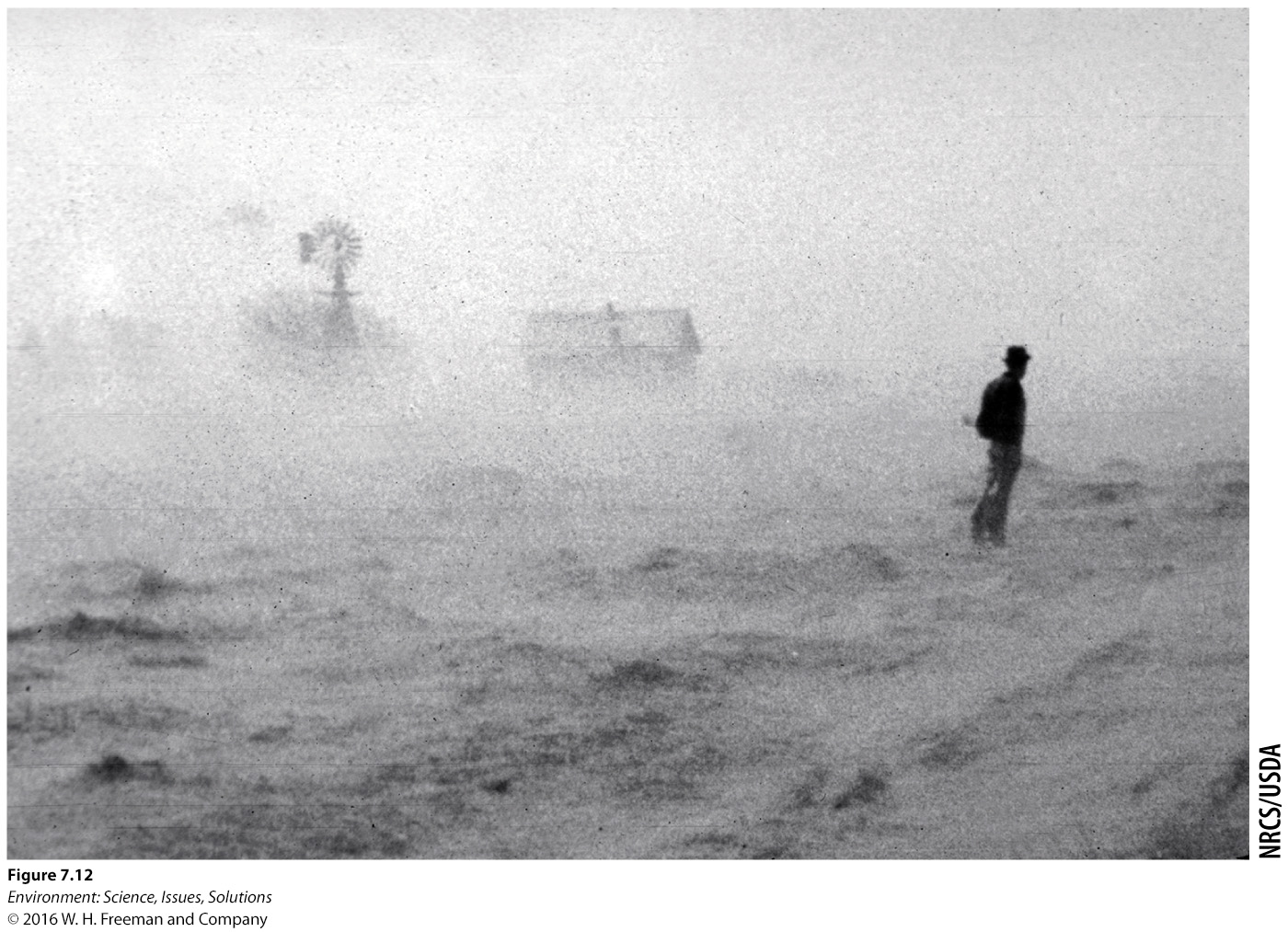My Slide Activities
Critical Analysis Question
Introduction
Chapter 7. Critical Analysis Question
Introduction
My Slide Activities
true
true
You must read each slide, and complete any questions on the slide, in sequence.
Critical Analysis Question:
At the height of the Dust Bowl U.S. President Franklin D. Roosevelt said, “The nation that destroys its soils destroys itself.” Explain his rationale.

To formulate your answer, first consider these additional thought questions:
Question 1
1.
Which of the following statements are true regarding soil development? Select all that apply. Soil forms as wind, water, and biological activity interacts with parent material. Soils develop only from biological processes. Climate influences soil development via temperature changes and precipitation. Soils develop very rapidly, as is demonstrated by erosion. Soil development is a slow process. ::Soil forms as wind, water, and biological activity interacts with parent material.: The parent material is usually a deep layer of foundational rock that is impacted by weathering and chemical processes.::Soils develop only from biological processes.: Chemical and physical processes also drive soil development.::Climate influences soil development via temperature changes and precipitation.: For example, freezing and thawing in cold climates incite the weathering of rocks, contributing to soil formation.::Soils develop very rapidly, as is demonstrated by erosion.: Erosion relates to soil loss, not development.::Soil development is a slow process.: Under certain conditions it could take over 100 years to form just a single inch of topsoil.2. Which of the following statements are true regarding soil development?
Question 2
2.
Now that you understand that soil development occurs slowly and involves many interactive processes, let’s explore the process of erosion. First, how would you define erosion?
A. B. C. D. CorrectIncorrect
Question 3
3.
Which of the following can cause erosion? Select all that apply. Solar rays Rainfall Plants Human activities Wind ::Solar rays: Solar rays may dry the soil and make it more prone to erosion, but they do not cause erosion.::Rainfall: Rainwater can carry soil particles in the form of runoff, and steeper slopes are more vulnerable to erosion.::Plants: In general, plants help to stabilize soil and reduce erosion because their roots form a sort of anchor in the soil and their leaves form a barrier to direct rainfall, lessening the impacts of both rain and wind erosion.::Human activities: Human activities, such as tilling and logging, can both cause and greatly exacerbate erosion.::Wind: In the case of the Dust Bowl era, tons of surface soils were blown across the landscape.3. Which of the following can cause erosion?
Question 4
4.
Farming in the Great Plains in the early 1900s involved the removal of native grasslands in order to plant crops. After the harvest, much of this farmland was left barren, and when an extended drought occurred in the region, massive quantities of soil were blown away because there were no plants growing to stabilize the soil. Why was the Dust Bowl era’s erosion considered harmful to future crop production in the United States? The erosion completely changed the parent material from which future soil would develop. Without a healthy layer of top soil, plant growth can be stunted, as this layer is typically rich in specific nutrients, such as nitrogen, phosphorus, and potassium. The erosion prevented water from moving down into the soil, significantly reducing groundwater availability for future crops. A thin top soil horizon is prone to drying, which can lead to crop failure since suitable soil moisture levels cannot be maintained. ::The erosion completely changed the parent material from which future soil would develop.: It was the surface layers of soil that were heavily eroded in the Dust Bowl era, not the parent material, which remained basically unchanged.::Without a healthy layer of top soil, plant growth can be stunted, as this layer is typically rich in specific nutrients, such as nitrogen, phosphorus, and potassium.: ::The erosion prevented water from moving down into the soil, significantly reducing groundwater availability for future crops: The erosion did not cause a reduction in groundwater availability; it was the drought that caused the regional water availabilty to decline.::A thin top soil horizon is prone to drying, which can lead to crop failure since suitable soil moisture levels cannot be maintained.:4. Farming in the Great Plains in the early 1900s involved the removal of native grasslands in order to plant crops. After the harvest, much of this farmland was left barren, and when an extended drought occurred in the region, massive quantities of soil were blown away because there were no plants growing to stabilize the soil. Why was the Dust Bowl era’s erosion considered harmful to future crop production in the United States?
Critical Analysis Question
5.
Now we return to the original Critical Analysis Question: At the height of the Dust Bowl U.S. President Franklin D. Roosevelt said, “The nation that destroys its soils destroys itself.” Explain his rationale.
7.1 Activity Completed!
Activity results are being submitted...